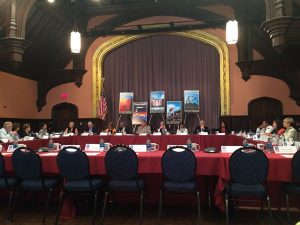A few weeks ago, the Advisory Council on Historic Preservation requested input on the future of the national historic preservation program. As part of this effort, they released a 13-page document that included 3 goals, 15 strategies, and 82 ideas. As I struggled with how to respond, I scribbled my initial thoughts on their request here. I will scribble more posts with my response to them in the coming days. (These posts can be found here, here, and here.)
Many preservationists are reflecting on the first 50 years of the National Historic Preservation Act and the future of preservation. The National Trust for Historic Preservation dedicated an entire issue of their Forum Journal last fall to the future of preservation and this fall, Forum Journal will include a retrospective of the last 50 years. This summer, Bending the Future (edited by Max Page and Marla R. Miller) was released, outlining 50 ideas for the next 50 years of preservation ranging from expanding the National Register of Historic Places and creating a modern-day Works Progress Administration to decolonizing or even repealing the National Historic Preservation Act.

Despite the discordant murmurs emanating from the field, the Advisory Council remained fairly quiet until May when they released their paper “The National Historic Preservation Program at 50: Challenges, Opportunities, and Priorities” based on their own research and comments on an initial draft received through the winter and early spring. That paper serves as the foundation for their most recent request.
The perceived silence of the Advisory Council is noticeable in that they are the one federal entity with the National Historic Preservation Act mandate to “advise the President and Congress on matters relating to historic preservation, recommend measures to coordinate activities of Federal, State, and local agencies and private institutions and individuals relating to historic preservation, and advise on the dissemination of information pertaining to those activities [54 USC 304102].” While individual members of the Advisory Council and their staff certainly have been part of conversations on the future of preservation at Advisory Council and other organizations’ meetings, I had hoped that by now a new national plan of action would have been released.
To be fair, another important cog in the preservation wheel—state historic preservation officers (a.k.a. SHPOs)—has also been fairly silent at the national level. As a former deputy SHPO in two states and a former member of the board of the National Conference of State Historic Preservation Officers (NCSHPO), I contributed to that silence though I did what I could to add to the conversation when given the opportunity. I can only speak from my own perspective, but SHPOs may have been left out of various conversations (either purposefully or accidentally) or asked to be part of them only to serve as a target for what is wrong with historic preservation today. They also may have declined to participate, as I have found that people in publicly funded preservation positions are often reticent to voice their actual opinions due to political concerns (either perceived or actual). NCSHPO is one venue to aggregate those opinions and present them on a national level, and I know they have throughout these discussions.
But the question remains: who should craft the future of preservation in the United States? The Advisory Council’s ideas are worth a slog through, but do not serve as a plan of action (at least not yet). The National Trust publications provide lofty goals on which most of us would agree to some degree or another, but also do not serve as a plan of action. Bending the Future contains numerous intriguing ideas but no broad-based consent.
It seems to me that we need to be (should have been?) working more closely together on a national plan of action to incite much-needed changes in both law and practice. Instead, we all tend to huddle within our preservation cliques, envision our own utopian preservation future, and then become frustrated when there is no way to put it into practice. I hope that the Advisory Council’s efforts still have an opportunity to craft a national plan of action. In order for that to happen, though, I also hope that people in all preservation sectors responded to their request for input on the plethora of goals, strategies, and ideas. Preservation is most successful when we work together toward the same end result.

